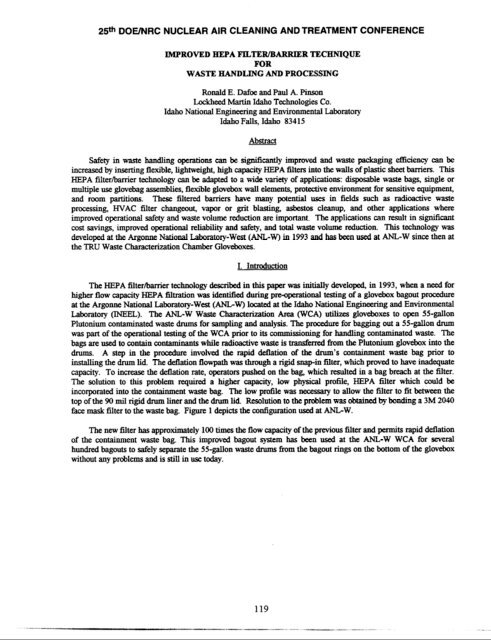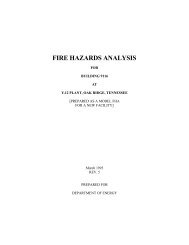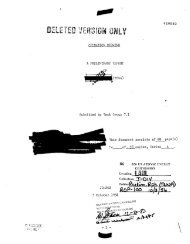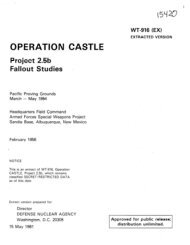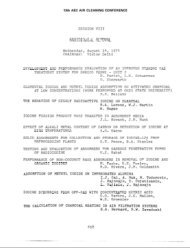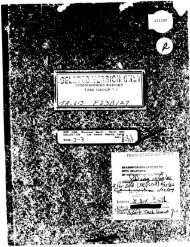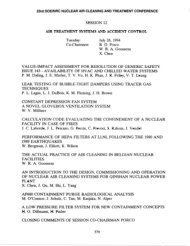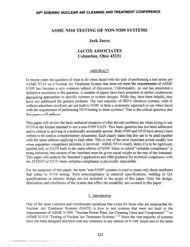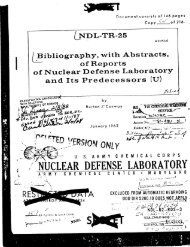Improved HEPA Filter/Barrier Technique For Waste Handling And ...
Improved HEPA Filter/Barrier Technique For Waste Handling And ...
Improved HEPA Filter/Barrier Technique For Waste Handling And ...
Create successful ePaper yourself
Turn your PDF publications into a flip-book with our unique Google optimized e-Paper software.
25th DOE/NRC NUCLEAR AIR CLEANING AND TREATMENT CONFERENCE<br />
IMPROVED <strong>HEPA</strong> FILTER/DARRIER TECHNIQUE<br />
FOR<br />
WASTE HANDLING AND PROCESSING<br />
Ronald E. Dafoe and Paul A. Pinson<br />
Lockheed Martin Idaho Technologies Co.<br />
Idaho National Engineering and Environmental Laboratory<br />
Idaho Falls, Idaho 83415<br />
Abstract<br />
Safety in waste handling operations can be signifkantly improved and waste packaging efficiency can be<br />
increased by inserting flexible, lightweight, high capacity <strong>HEPA</strong> filters into the walls of plastic sheet barriers. This<br />
<strong>HEPA</strong> filter/barrier technology can be adapted to a wide variety of applications: disposable waste bags, single or<br />
multiple use glovebag assemblies, flexible glovebox wall elements, protective environment for sensitive equipment,<br />
and room partitions. These filtered barriers have many potential uses in fields such as radioactive waste<br />
processing, HVAC filter changeout, vapor or grit blasting, asbestos cleanup, and other applications where<br />
improved operational safety and waste volume reduction are important. The applications can result in signiiicant<br />
cost savings, improved operational reliability and safety and total waste volume reduction. This technology was<br />
developed at the Argonne National Laboratory-West (ANL-W) in 1993 and has been used at ANL-W since then at<br />
the TRU <strong>Waste</strong> Characterization Chamber Gloveboxes.<br />
I. Introduction<br />
The <strong>HEPA</strong> filter/barrier technology described in this paper was in.itiaIly developed, in 1993, when a need for<br />
higher flow capacity <strong>HEPA</strong> Iiltration was identified during preqerational testing of a glovebox bagout procedure<br />
at the Argonne National Laboratory-West @L-W’) located at the Idaho National Engineering and Environmental<br />
Laboratory (INEEL). The ANL-W <strong>Waste</strong> Characterization Area (WCA) utilizes gloveboxes to open 55-gallon<br />
Plutonium contaminated waste drums for sampling and analysis. The procedure for bagging out a 55-gallon drum<br />
was part of the operational testing of the WCA prior to its commissioning for handling contaminated waste. The<br />
bags are used to contain contaminants while radioactive waste is transferred from the Plutonium glovebox into the<br />
drums. A step in the procedure involved the rapid deflation of the dnmt’s containment waste bag prior to<br />
installing the drum lid. The deflation flowpath was through a rigid snap-in filter, which proved to have inadequate<br />
capacity. To increase the deflation rate, operators pushed on the bag, which resulted in a bag breach at the filter.<br />
The solution to this problem required a higher capacity, low physical profile, <strong>HEPA</strong> filter which could be<br />
incorporated into the containment waste bag. The low profile was necessary to allow the filter to fit between the<br />
top of the 90 mil rigid drum liner and the drum lid. Resolution to the problem was obtained by bonding a 3M 2040<br />
face mask filter to the waste bag. Figure 1 depicts the contiguration used at ANL-W.<br />
The new filter has approximately 100 times the flow capacity of the previous filter and permits rapid deflation<br />
of the containment waste bag. This improved bagout system has been used at the ANL-W WCA for several<br />
hundred bagouts to safely separate the 55-gallon waste drums from the bagout rings on the bottom of the glovebox<br />
without any problems and is still in use today.<br />
119
25th DOE/NRC NUCLEAR AIR CLEANING AND TREATMENT CONFERENCE<br />
FIGURE 1<br />
Argonne National Laboratories-West Bag with <strong>Filter</strong>s Installed<br />
Glovebox Bagging Ring<br />
ANL-WBag __*<br />
II. Technologv Basis<br />
safety respirator mask manufacturers including 3M, North safety, and US Safety are using polypropylene<br />
blown microfibers (BMF) to produce small, flexible, rugged, and high capacity <strong>HEPA</strong> filters, as depicted in Figure<br />
2.<br />
The 3M and US Mety filters rely on electmstatics to enhance filtering with charged fiber filters, while the North<br />
system relies on mechanical filtering. These filters are ideal for filter mask applications because they are relatively<br />
inexpensive, reliable, and simple to mar~uf&tm-e.<br />
FIGURE 2<br />
TYPICAL CIRCULAR F’LEXIBLE BREATHING AIR MASK FILTER<br />
(FILTER SECTIONED FOR CLARFIII)<br />
Circular Edge Weld<br />
Center Bafne<br />
Adapter Fitting<br />
120<br />
<strong>Filter</strong> Element
25th DOE/NRC NUCLEAR AIR CLEANING AND TREATMENT CONFERENCE<br />
BMF <strong>Filter</strong> Media<br />
BMP filter media is made by spray forming a thin mat of polypropylene fibers into large sheets of filter media<br />
in a manner similar to the way paint is sprayed from a paint gun onto a flat surface. This media has excellent wet<br />
strength and won’t support the growth of mold, mildew, fungus or bacteria. The cloth-like non-woven fabric is<br />
similar to the material used in the garment industry to make polypropylene athletic garments. Like athletic<br />
garments, this filter technology can be expanded by tailoring the mat material or by selectively layering the mat<br />
with other media to include enhanced features that are available by layering or bonding the BMF with special<br />
materials that adsorb, absorb, or chemically react with vapors, mists, or gasses.<br />
A filter can be made by layering as many of the filter media mats as desired to meet the required filtering<br />
efficiencies. Because the filter media is made in large rolls, like regular cloth, the size of the filter is easily<br />
adaptable within reasonable limits to meet the needs of the application. Each filter is usually covered with a scrim,<br />
or cover material, most oflen a BMF material, to protect it from abrasion and provide some additional structural<br />
integrity. The resulting filters are rugged, flexible, and easily sized to meet any application.<br />
III. Technologv Develoument<br />
The high flow capacity, flexible, and rugged <strong>HEPA</strong> filters are practical for many applications in a number of<br />
industries. The BMF fabrication process can be tailored to produce a variety of media that are suitable for specific<br />
services such as air filters, waste containment box liners, filter vented waste bags, and clean room enviromnent<br />
barriers.<br />
The initial application of the filter/barrier technology at ANL-W directly thermal heat sealed the filter into<br />
polyethylene glovebags. Thermal impulse heat sealing is the preferred method to join BMF <strong>HEPA</strong> filters to<br />
polyethylene plastic barrier material because it produces a permanently welded high integrity joint that is flexible<br />
and tough with a much longer life than an adhesive joint. The thermal heat sealing joint provides improved<br />
operational safety because it can flex around comers that could tear barrier material from rigid filters.<br />
Containment bags with BMP filters could increase the loading of Pu238 contaminated radioactive waste in<br />
55-gallon drums destined for shipment to the <strong>Waste</strong> Isolation Pilot Plant (WIPP). A result of this would be<br />
decread costs associated with packaging and shipping. Some waste packaging is limited by the ability of the bag<br />
filters to diffuse hydrogen and keep the concentration below the lower explosive limit. Specialized inert, or<br />
controlled flowing gas environments can be established inside barriers while maintaining filtered inlets and outlets.<br />
Inserting the high flow capacity <strong>HEPA</strong> filter into an otherwise airtight barrier allows the barrier to breathe<br />
quickly and adjust to pressure changes. The time needed to deflate a sealed comainment bag can be significantly<br />
reduced and sudden pressure changes or reversals will not cause loss of containment<br />
IV. Technical Challenges<br />
A fabrication limitation is that polypropylene filters will only heat seal to polyethylene or polypropylene<br />
sheeting. Direct bonding of a polypropylene filter into a polyethylene barrier by a thermal impulse heat seal is the<br />
preferred method of barrier constmction. The two materials are similar enough in chemical structure that a<br />
satisfactory weld can be achieved with appropriate equipment. This method of direct plastic welding has not been<br />
achieved for filter attachment to PVC or polyurethane sheets. Attempts at radio frequency and ultrasonic welding<br />
methods have been m. PVC and polyurethane require other methods which can include physical<br />
attachment within a pocket through the combination of heat sealing and adhesive bonding. This method, currently<br />
used at ANL-W because of their use of PVC bags, is shown in Figure 3.<br />
121
25th DOE/NRC NUCLEAR AIR CLEANING AND TREATMENT CONFERENCE<br />
I PVC <strong>Barrier</strong><br />
Material<br />
Around <strong>Filter</strong><br />
I<br />
FIGURE 3<br />
CONTJNUOUS VENTING PVC POCKET AROUND FILTER<br />
(FILTER SECTIONED FOR CLARITY)<br />
/<br />
Circular Edge Weld<br />
Adapter Fitting<br />
I<br />
A similar pocketing technique, as shown in Figure 4, can be made airtight by sealing the barrier material to<br />
the flange of the adapter fitting. With this method, a vacuum or blower system could be attached to the adapter<br />
fitting for a more controlled air flow through the filter. In addition, special fittings or tape can cover the outlet of<br />
the adapter fitting to seal the bag.<br />
l<br />
PVC Bank<br />
MateliaI<br />
Around <strong>Filter</strong><br />
FIGURE 4<br />
AIRTIGHT hALADLE PVC POCKET AROUND FILTER<br />
(FILTER SECTIONED FOR CLARITY)<br />
/<br />
Circular Edge Weld<br />
<strong>Filter</strong> Element<br />
scdm<br />
Another option is to create a patch assembly, as shown in Figure 5, that relies on housing the filter in a scrim<br />
material that is weldable to the barrier material.<br />
122
25th DOE/NRC NUCLEAR AIR CLEANING AND TREATMENT CONFERENCE<br />
<strong>Barrier</strong> Material<br />
Weldable Patch<br />
/<br />
Circular Edge Weld<br />
(Made at final assembly)<br />
FIGURE 5<br />
CIRCULAR PATCH WELDABLE FILTER<br />
(FILTER SECTIONED FOR w<br />
Adapter Fitting<br />
V. Onerational Variations<br />
Patch<br />
Different mounting configurations of a filter to a barrier can provide a variety of operational capabilities.<br />
Possibilities include:<br />
l Airtight mounting of a single filter in a bag type barrier with an integral outlet fitting so the only exit from the<br />
filter is through the outlet, creating an airtight barrier. This barrier can then be used for deflating and sealing<br />
compressible waste. The waste would be sealed inside the bag with a linear heat seal (Seal-A-Meal type) and<br />
then the air would be vacuumed from the bag without spreading comaminants.<br />
0 Airtight mounting of two filters with outlet fittings on opposite sides of the volume enclosing barrier to create<br />
a microenvironment in which experiments could be performed with controlled atmospheric conditions. Both<br />
the inlet and outlet would be filtered to prevent introduction or escape of undesired products or contaminants.<br />
This is an ideal construction for contagious disease testing on mice or other biological testing systems.<br />
l Open face mounting of small filters without fittings provide continuous venting of gasses generated inside the<br />
barrier. This is ideal for packaging that needs to vent radiolyticly generated hydrogen to prevent the buildup of<br />
explosive levels of gasses.<br />
0 Large panel mounted filters in walls or ceilings provide excellent protection from overpressure conditions. The<br />
sudden starting or stopping of a large air-circulating fan would not collapse a barrier that was made of this<br />
type of material. Such a barrier could zone a large contaminated area into smaller easier cleaned zones for<br />
individual reclamation.<br />
l Panel or frame mounted filters could provide low flow resistance and pre-filters for <strong>HEPA</strong> or other filters that<br />
are subjected to high loading from dust or other contaminants. The pre-filters would reduce the complexity of<br />
changeout of the <strong>HEPA</strong> filter and if the design of the containment was amenable, the pre-filter could be<br />
collapsed and bagged out from inside of the containment with much greater ease than the main filter.<br />
l Custom bags with special inlet and outlet <strong>HEPA</strong> filters could protect temperature or dust sensitive electronics<br />
or other items that require clean cooling air to be blown across the equipment. The bag filtered inlets and<br />
outlets would be strategically placed to direct the airflow across the normal equipment cooling paths.<br />
123
25th DOE/NRC NUCLEAR AIR CLEANING AND TREATMENT CONFERENCE<br />
VI. Auplications in Diverse Fields<br />
Potential exists for application of the filter/barrier technology in other than the nuclear waste handling arena.<br />
Possibilities include:<br />
l Medical isolation tents could be created to isolate patients to control contagious diseases. The filtered air inlet<br />
and outlet panels would filter air with the rest of the room or the tent could be sealed from the outside<br />
environment with specially purified and filtered atmospheres. This could be used to provide unique care<br />
conditions for a patient with special susceptiiilities.<br />
l Microenvironments for biological or medical experimentation could be created with specially filtered bags.<br />
The experimental environment could be controlled and after the test all the contents could be left in the bag<br />
and the entire experiment could be destroyed by incineration or rendered harmless by autoclaving.<br />
l Biological hazardous waste containment could be evacuated by attaching a vacuum to the outlet of the filter for<br />
volume reduction and later destroyed by incineration or auto&wing.<br />
l A sand, grit, or other particle blasting tent could be created to house the blast nozzle on applications where the<br />
byproducts are contained for ease of cleanup or safety.<br />
l Containment for dry ice pellet blast cleaning of contaminated parts could be created that would result in the<br />
CO2 evaporating and only the material removed from the part remaining inside the bag. This would be<br />
especially valuable for processes like lead cleanup where the blasting byproducts are hazardous.<br />
l Protective packaging could be made for sensitive electronic equipment. In this application, special bags could<br />
be made with filtered inlet and outlets that are located at the same place the equipment normally draws and<br />
discharges air. This could be used for heavy constmction, fbrming, or military equipment where the outside<br />
environment is not controllable.<br />
l Presswe equalization barrier to withstand changes in pressure across the barrier could be created. An example<br />
is a series of barriers within a large area that creates smaller chambers where smaller areas can be<br />
decontaminated individually. The smaller areas remain isolated so they do not become recontaminated as the<br />
cleaning process is completed.<br />
l Gloveboxes with <strong>HEPA</strong> filtered flow-through ventilation systems could be created. They would normally rely<br />
on negative internal pressure to prevent comaminating the outside areas. This method could mimmize the<br />
possibility of contaminating the outside environment if pressure inside the box becomes positive.<br />
VII. Nuclear <strong>Waste</strong> Industrv Benefits<br />
This technology is being evaluated for use in packaging waste to ship to WIPP. Some radioactive waste forms<br />
are shipped to WIPP in sealed 55-gallon drums that have been fitted with <strong>HEPA</strong> drum vent filters in the lids to<br />
vent HZ that might have been generated by radiolytic decomposition of hydrogenous materials.<br />
The amount of radioactive waste that can be shipped in each drum is severely limited unless the plastic<br />
barriers inside the drums are also vented. Hz difiusivity of the drum and bag vent filters must be adequate to<br />
prevent the buildup of the HZ inside the drum from reaching an explosive level. The <strong>HEPA</strong> filters installed in<br />
plastic bags with this technology have a high enough difkivity that they can eliminate the waste loading<br />
restrictions that are imposed because of Hz buildup. It is feasible that a 20% increase in waste loading could be<br />
achieved. This would result in significant cost savings in shipping and storing WIPP waste.<br />
VIII. summarv<br />
The filter/barrier technology allows the creation of an inexpensive, readily available, and disposable <strong>HEPA</strong><br />
filtered containment barrier which can be used in a variety of applications where contamination control and waste<br />
124
volume reduction are concerns. Enhanced safety, sign&ant cost reductions, operational simplification, and<br />
convenience can be achieved through the use of this technology.<br />
IX. AcknowledgJnents<br />
This work was originally developed under federally funded research and development conducted at the Idaho<br />
National Engineering and Environmental Laboratory under U.S. Department of Energy Contract, DE-AC07-<br />
76IDO1570.<br />
The original application of this technology was conceived and developed by Paul A. Pinson, who was granted<br />
US Patent No. 5.720,789 on February 24, 1998 titled “METHOD FOR CONTAMINATION CONTROL AND<br />
BARRIER APPARATUS WITH FILTER FOR CONTAINING WASTE MATERIALS THAT INCLUDE<br />
DANGEROUS PARTICULATE MATTER” The rights for this patent were assigned to Lockheed Martin Idaho<br />
Technologies Compaq, Idaho Falls, ID.


